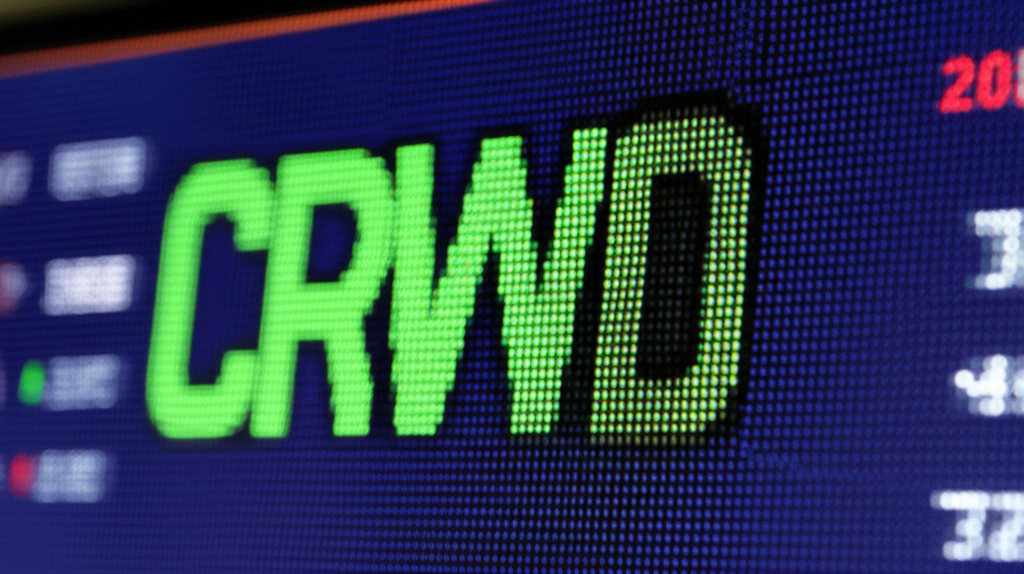CrowdStrike Stock Slips: Analyst Downgrades Before Earnings
CrowdStrike Holdings (NASDAQ: CRWD) saw its stock slide in early trading, a move largely attributed to a significant analyst downgrade just days ahead of the cybersecurity giant’s eagerly anticipated quarterly earnings report. The pre-earnings jitters, amplified by a revised rating, underscore the volatile nature of high-growth tech stocks and the outsized influence of institutional analyst sentiment in today’s market. For young investors keenly following the intersection of technology and finance, this development offers a crucial lesson in market dynamics and the careful calibration of expectations.
The shift in analyst perception came from Baird Capital, where veteran tech analyst David Williams adjusted his rating on CrowdStrike from “Outperform” to “Neutral.” Accompanying this downgrade was a notable reduction in the price target, pulling it down from $350 to $300 per share. Williams’ rationale, as detailed in his research note, primarily cited concerns over the company’s valuation, which he now views as fully reflecting its impressive growth trajectory. While acknowledging CrowdStrike’s robust market position and continued execution, the analyst suggested that the current share price leaves limited upside potential given prevailing market conditions and a nuanced outlook for enterprise spending.
This re-evaluation by Baird Capital isn’t an isolated event but rather indicative of a broader recalibration occurring across the tech sector. Analysts and institutional investors are increasingly scrutinizing profitability and sustainable free cash flow generation, often at the expense of pure top-line growth, especially as interest rates remain elevated. For CrowdStrike, a pioneer in cloud-native endpoint and workload protection, its rapid expansion and recurring subscription revenue model have long commanded premium valuations. However, the cybersecurity landscape is intensely competitive, with formidable players like Microsoft, Palo Alto Networks, and SentinelOne constantly innovating and vying for market share. Williams’ note reportedly highlighted intensifying competition and potential macroeconomic headwinds affecting enterprise IT budgets as contributing factors to a more cautious outlook for the company’s growth acceleration. This isn’t to say CrowdStrike’s growth is stalling; rather, it’s a re-assessment of whether its *rate* of growth can continue to justify its historically high multiples in a more demanding investment environment.
The timing of this downgrade, just prior to CrowdStrike’s fiscal quarterly earnings call, adds an extra layer of tension. Earnings reports for companies like CrowdStrike are pivotal events that can either validate or challenge market narratives. Investors will be poring over several key metrics to gauge the company’s health and future trajectory. Beyond the headline revenue and earnings per share figures, the focus will be intensely on subscription revenue growth, annual recurring revenue (ARR) – a critical indicator of the company’s recurring revenue base – and customer additions. Equally important will be the company’s profitability metrics, such as non-GAAP operating margins and free cash flow, demonstrating its efficiency in converting revenue into cash. Crucially, the forward guidance provided by management for the upcoming quarter and the full fiscal year will likely dictate the stock’s movement post-earnings. Any deviation from expectations, particularly on the guidance front, could either exacerbate the recent slip or trigger a recovery.
Analyst downgrades, while influential, are just one piece of the complex puzzle that determines a stock’s performance. They reflect a specific firm’s or individual analyst’s perspective at a given time and can sometimes be contrarian indicators. However, for a high-profile, high-valuation stock like CrowdStrike, a downgrade from a prominent firm can trigger automated selling and influence broader market sentiment, especially when investors are already on edge. This situation highlights the importance of not relying solely on analyst ratings, but rather conducting thorough due diligence, understanding a company’s fundamentals, its competitive advantages, and the broader market context.
As the market braces for CrowdStrike’s earnings report, all eyes will be on how the company addresses the growth trajectory and profitability concerns underscored by this recent downgrade. For young investors, this episode serves as a powerful reminder that even market leaders are subject to re-evaluation, and that a deep understanding of a company’s business model, its competitive environment, and macroeconomic forces is paramount in navigating the often-turbulent waters of stock market investing. The true test for CrowdStrike, and indeed for its investors, will come when it lays bare its latest financial performance and future outlook.





